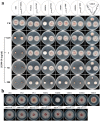Whole-genome sequencing reveals that mutations in myosin-5 confer resistance to the fungicide phenamacril in Fusarium graminearum
- PMID: 25648042
- PMCID: PMC5389027
- DOI: 10.1038/srep08248
Whole-genome sequencing reveals that mutations in myosin-5 confer resistance to the fungicide phenamacril in Fusarium graminearum
Abstract
To determine the mechanism of resistance to the fungicide phenamacril (JS399-19) in Fusarium graminearum, the causal agent of Fusarium head blight, we sequenced and annotated the genome of the resistant strain YP-1 (generated by treating the F. graminearum reference strain PH-1 with phenamacril). Of 1.4 million total reads from an Illumina-based paired-end sequencing assay, 92.80% were aligned to the F. graminearum reference genome. Compared with strain PH-1, strain YP-1 contained 1,989 single-nucleotide polymorphisms that led to amino acid mutations in 132 genes. We sequenced 22 functional annotated genes of another F. graminearum sensitive strain (strain 2021) and corresponding resistant strains. The only mutation common to all of the resistant mutants occurred in the gene encoding myosin-5 (point mutations at codon 216, 217, 418, 420, or 786). To confirm whether the mutations in myosin-5 confer resistance to phenamacril, we exchanged the myosin-5 locus between the sensitive strain 2021 and the resistant strain Y2021A by homologous double exchange. The transformed mutants with a copy of the resistant fragment exhibited resistance to phenamacril, and the transformed mutant with a copy of the sensitive fragment exhibited sensitivity to phenamacril. These results indicate that mutations in myosin-5 confers resistance to phenamacril in F. graminearum.
Conflict of interest statement
The authors declare no competing financial interests.
Figures




References
-
- Kluth J., Santel H. J. & Schmidt R. R. Bayer AG, 3-Amino-2-cyano-acrylic acid ester herbicides. United States patent US 4,832,733, 1989. May 23.
-
- Liu Y. X. et al. Synthesis herbicidal activities and 3D-QSAR of 2-cyanoacrylates containing aromatic methylamine moieties. J Agric Food Chen 56, 204–212 (2008). - PubMed
-
- Blum G. N., Nolte W. A. & Robertson P. B. In vitro determination of the antimicrobial properties of two cyanoacrylate preparations. J Dent Res 54, 500–503 (1975). - PubMed
-
- Long N. et al. Synthesis and antiviral activities of cyanoacrylate derivatives containing an alpha-aminophosphonate moiety. J Agric Food Chen 56, 5242–5246 (2008). - PubMed
-
- Song B. A. et al. Synthesis and bioactivity of 2-cyanoacrylates containing a trifluoromethyl moiety. J Fluorine Chen 126, 87–92 (2005).
Publication types
MeSH terms
Substances
LinkOut - more resources
Full Text Sources
Other Literature Sources

